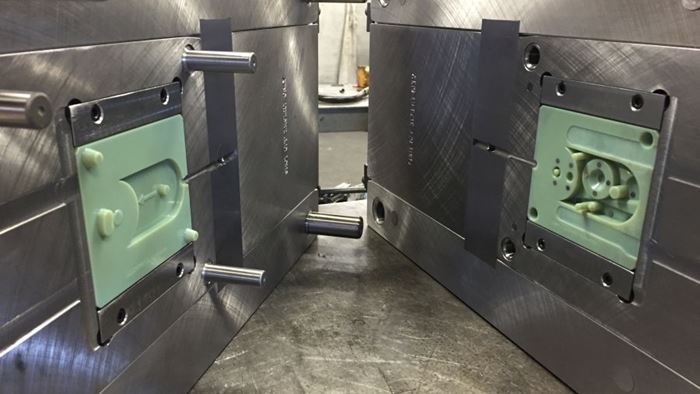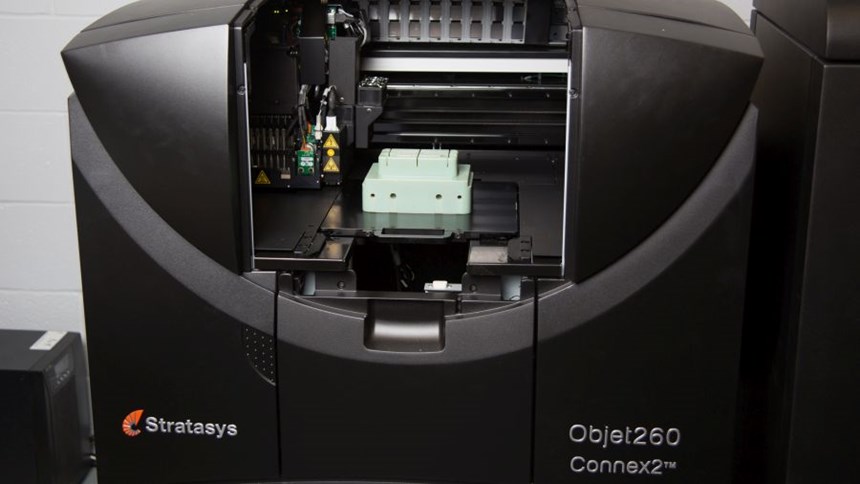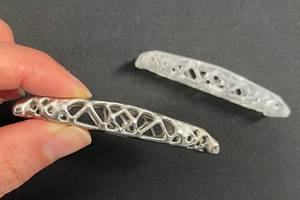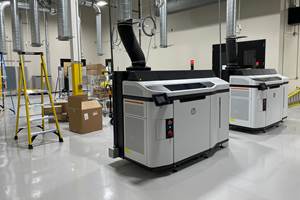Expanding Horizons with Rapid Tooling
Investing in 3D printing for rapid tooling brought product development time from months down to weeks for this moldmaker.
Providing customers with the ability to produce a production-intent component in the production-specified engineered resin in days rather than weeks is the goal of many mold manufacturers and molders. But today, Accu-Mold LLC, a certified minority business enterprise based in Portage, Michigan, can say they reached that goal. The company recently invested in rapid tooling capabilities using 3D printing.
After years of outsourcing 3D printing, Accu-Mold decided to install a Stratasys Objet260 Connex2 and Objet30 Pro mid-2015 to print sample parts and molds to speed product development time for its customers.
Accu-Mold specializes in metal to plastic conversion, but didn’t just want to deliver 3D-printed components. They wanted to leverage additive manufacturing (AM) for rapid tooling development, according to Accu-Mold President Dave Felicijan.
The addition of AM for rapid tooling affords their customers a much shorter lead time over multiple standard aluminum prototype molds and trials. 3D-printed rapid tools can be turned around within three to six business days while maintaining the integrity of the production-intent material for both design and product validation.
And with the analytical design tools at their disposal, such as MoldFlow, FEA and cooling analysis, and the ability to prototype quickly, Accu-Mold can ensure an efficient manufacturing process within weeks as opposed to months. This means their customers get their products to market much sooner.
To date, Accu-Mold has produced a number of printed tools and each one presents its own set of challenges. For example, getting cooling into the mold or using some type of system to quickly cool the part before ejection. “To date, we have printed three tools and their respective molded parts. We also have two more in design. The first three were single-cavity prototype tools and the other two in design are single-cavity production pull ahead tools,” says Felicijan.
The first rapid tooling project was for the welding aftermarket component industry. The part is used for wire welding and is assembled in a “chain” to straighten the wire as it is pulled from a distance. The geometry of the part proved to be challenging due to thin walls and deep draw. However, Accu-Mold used recommended guidelines for the ratio of wall thickness, maximum material load, etc. from the printer manufacturer, as well as experience with standard tooling prototypes and scientific molding, to design and build the rapid tool.
Stratasys’ digital ABS material was used along with proprietary cooling, and runner and gate sizing calculations based on product size, material and wall thickness. The tool was built in four business days with molded production-intent components on the fifth business day. This project saved thousands of dollars in labor and material compared to a standard aluminum prototype tool.
Felicijan notes that Accu-Mold’s customers have been eager to use the rapid tooling capability for components that would normally take 12 to 14 weeks for prototyping and design validation testing. “When the process is presented to the customer, they want to use it right away. However, it doesn’t meet the needs of all applications. It’s important to act quickly yet realistically based on the variables presented. For example, we have development underway for higher temperature materials,” says Felicijan.
Currently, about 60 percent of Accu-Mold’s business is mold building and 40 percent is automotive and commercial molding. The company is looking to use its new AM capabilities to diversify into medical and defense products because of their reduced product life cycles and legacy component and assemblies, respectively. Additionally, Accu-Mold hopes to achieve a higher concentration of contract manufacturing by expanding into advanced AM, including metal 3D printing.
Related Content
Possibilities From Electroplating 3D Printed Plastic Parts
Adding layers of nickel or copper to 3D printed polymer can impart desired properties such as electrical conductivity, EMI shielding, abrasion resistance and improved strength — approaching and even exceeding 3D printed metal, according to RePliForm.
Read MoreWhat Does Additive Manufacturing Readiness Look Like?
The promise of distributed manufacturing is alluring, but to get there AM first needs to master scale production. GKN Additive’s Michigan facility illustrates what the journey might look like.
Read MoreThis Drone Bird with 3D Printed Parts Mimics a Peregrine Falcon: The Cool Parts Show #66
The Drone Bird Company has developed aircraft that mimic birds of prey to scare off problem birds. The drones feature 3D printed fuselages made by Parts on Demand from ALM materials.
Read MoreFDA-Approved Spine Implant Made with PEEK: The Cool Parts Show #63
Curiteva now manufactures these cervical spine implants using an unusual 3D printing method: fused strand deposition. Learn how the process works and why it’s a good pairing with PEEK in this episode of The Cool Parts Show.
Read MoreRead Next
Postprocessing Steps and Costs for Metal 3D Printing
When your metal part is done 3D printing, you just pull it out of the machine and start using it, right? Not exactly.
Read MoreCrushable Lattices: The Lightweight Structures That Will Protect an Interplanetary Payload
NASA uses laser powder bed fusion plus chemical etching to create the lattice forms engineered to keep Mars rocks safe during a crash landing on Earth.
Read MoreAlquist 3D Looks Toward a Carbon-Sequestering Future with 3D Printed Infrastructure
The Colorado startup aims to reduce the carbon footprint of new buildings, homes and city infrastructure with robotic 3D printing and a specialized geopolymer material.
Read More























